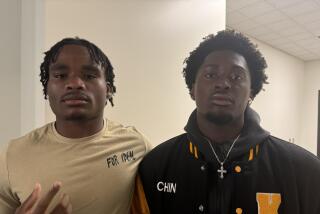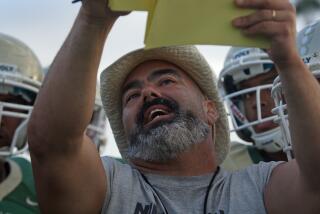Op-Ed: What a team — football and Jesus

Mississippi players pray in the end zone before an NCAA college football game against LSU in Baton Rouge, La. in 2014. As football season begins, with it comes religion on the gridiron.
Last month, on a febrile afternoon before practice, the defensive coach of the Villa Rica Wildcats and 18 of his football players were baptized in a stock trough on the Villa Rica High School football field in Villa Rica, Ga. They filled the trough with a garden hose and let Pastor Kevin Williams of the First Baptist Church push their heads backward under the water. This was not unprecedented: In 2012, wideout DeAndre “Nuk” Hopkins, now of the Houston Texans, was baptized on Clemson University’s 50-yard line. The Freedom From Religion Foundation objected, but nothing was done. Clemson’s head coach, Dabo Swinney, likes to say, “I’m a Christian. If you have a problem with that, you don’t have to be here.”
While a 100-gallon Rubbermaid trough isn’t exactly the River Jordan, it seemed to do the trick in Villa Rica. Soon after the serial immersions, the church posted a video on its website, crowing, “Take a look and see how God is STILL in our schools!” Never mind that the Supreme Court has ruled over and over that taxpayer-funded educational institutions cannot promote religion; nobody evicts the Lord from the locker room, in high school or in college football.
Jesus presides over the sport with an authority that the National Collegiate Athletic Assn. must envy. Most of the big football powers have team chaplains; many coaches throw down the Lord’s Prayer before kickoff. University of Mississippi football coach Hugh Freeze holds worship services on campus. The head football coach at the Air Force Academy once hung a banner in his fieldhouse declaring, “I Am A Christian First and Last,” though many of his players were not Christians first, last or in between.
Christianity and football, according to former Florida State and NFL star Deion Sanders, “go together like peanut butter and jelly” — and they have for a long time. The marriage between the Prince of Peace and America’s most warlike sport predates the Reagan era, when the religious right and the Republican Party became fatally entwined. In fact, it started more than a century ago, in England.
****
In the mid-19th century, some British prelates, writers and politicians fretted that Christianity had become wimpy. The greatest empire the world had ever known needed manly types to subdue the far-flung colonies in Africa and Asia, inspired not by the girly Jesus of Victorian stained-glass windows — all melting eyes and soft hair — but the tough Jesus who kicked over the money-changers’ tables like Clint Eastwood cleaning up a border town.
Muscular Christianity, as the movement was called, preached a clean soul in a beefy body, personified in Lord Alfred Tennyson’s “Idylls of the King” by Sir Galahad, a chivalric jock, a medieval Tim Tebow whose “strength is as the strength of ten” because his heart is “pure.” Muscular Christians looked back to the Apostle Paul, always exhorting the early church to be in it to win it: “Know ye not that they which run in a race run all, but one receiveth the prize? So run that ye may obtain it” (I Corinthians 9:24).
Christians could acquire spiritual and physical muscles through various means, but the Anglo-Saxon iterations of the ancient game of “mob football,” including soccer, rugby and gridiron — or American — football seemed particularly well suited for promoting godly masculinity.
In 1857, Thomas Hughes, a leading proponent of Muscular Christianity, published the bestselling novel “Tom Brown’s Schooldays,” a celebration of (among other devout pursuits) the take-no-prisoners contests at England’s Rugby School, which gave its name to the version of football in which a player can run with the ball. In a famous scene, Tom earns his classmates’ undying respect by hurling himself into the middle of an exuberantly violent match. He’s knocked out cold, but hey, he was going for the ball. Well done, sir!
Rugby football broke legs, bruised brains and cracked ribs, but it also built the kind of manly man needed, according to one unapologetic imperialist, to traverse the world “with a Bible in one hand and a rifle in the other.”
America picked up football, and Muscular Christianity, after the Civil War. The first official gridiron game — a hybrid of rugby and soccer — took place between Princeton and Rutgers in 1869. That same year, the first Young Men’s Christian Assn. gymnasiums opened in the U.S. If boys were working out, they weren’t sinning.
But more than chronological coincidence linked the two; they came together — were made flesh, you could say — in Amos Alonzo Stagg, a celebrated Yale football player who was also a committed Christian. In the early 1890s, evangelist Dwight Moody persuaded Stagg to help him spread the gospel of Muscular Christianity to college students. For Moody and Stagg, Christianity was about mightiness, not meekness, and football was the right medium for the message.
Hughes’ literary soldering of Christianity with bone-crunching tackles stretched across the Atlantic, too. Thomas Wentworth Higginson, a Unitarian minister worried that American men were deserting the Protestant church, helped popularize his works; even Teddy Roosevelt thought “Tom Brown’s Schooldays” one of the two books every boy should read.
Lest anyone wonder, football back then was more than a little dangerous. Between 1890 and 1905, at least 330 young men were killed playing football. Yet fatalities didn’t uncouple the sport from Christianity; in one remarkable case, death reinforced the relationship.
In 1897, a University of Georgia fullback named Richard Von Albade Gammon died of head trauma in a contest against the University of Virginia. Distressed and shocked, the Georgia Legislature passed a bill outlawing the game. But when the governor read a letter from Gammon’s mother begging that the sport her son regarded as “the highest type of manhood” be allowed to continue, the governor vetoed it. Gammon’s “sacrifice,” as his mother called it, was seen as “Christlike” — dying for others, giving his body for football.
****
Today, the NCAA purports to take care of players’ bodies. And the Fellowship of Christian Athletes, a “sports ministry” founded in 1954, purports to take care of their souls. The FCA has more than 8,000 chapters in high schools and colleges; it helps pay the salaries of team chaplains at state universities and sponsors sports camps. Many members of that Villa Rica football team attended an FCA camp before the stock trough baptism.
Seems no matter what you do, football and Jesus stick together. No pain, no gain, as coach says. Or is that preacher? Sometimes it’s hard to tell.
Diane Roberts is the author of “Tribal: College Football and the Secret Heart of America.”
Follow the Opinion section on Twitter @latimesopinion and Facebook
More to Read
A cure for the common opinion
Get thought-provoking perspectives with our weekly newsletter.
You may occasionally receive promotional content from the Los Angeles Times.










